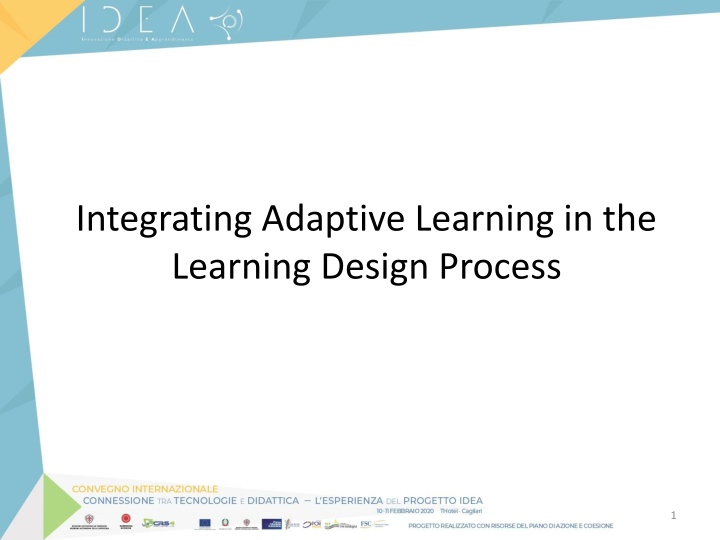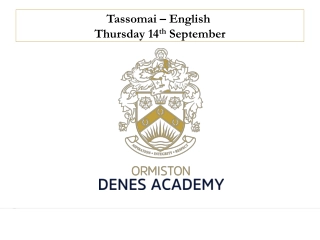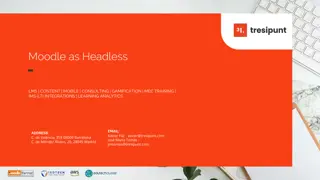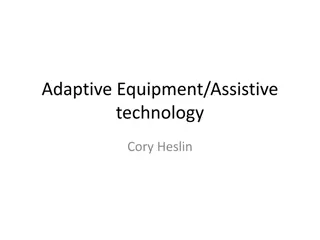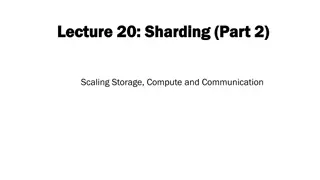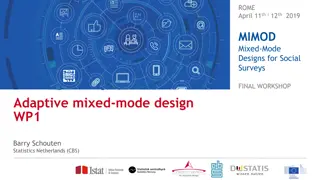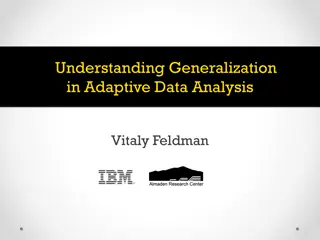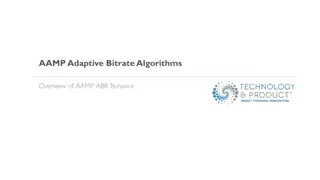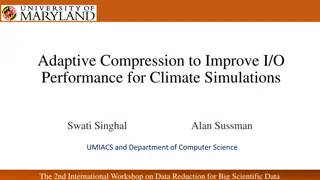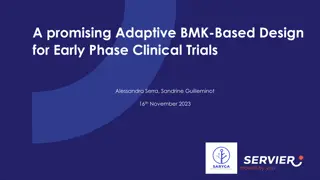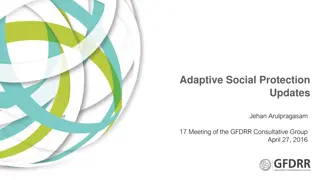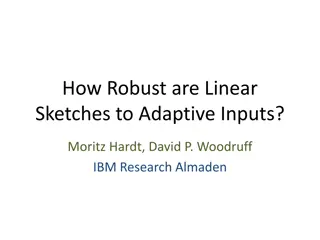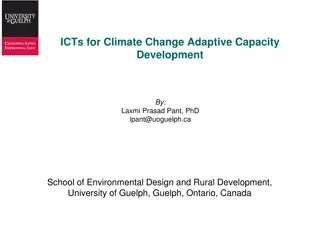Enhancing Learning Design with Adaptive Learning Solutions
Explore the integration of adaptive learning in educational design processes to address common challenges such as high drop-out rates and student disengagement. Discover key players in learning design and the benefits of intelligent adaptive learning systems in catering to individual student needs effectively.
Download Presentation

Please find below an Image/Link to download the presentation.
The content on the website is provided AS IS for your information and personal use only. It may not be sold, licensed, or shared on other websites without obtaining consent from the author.If you encounter any issues during the download, it is possible that the publisher has removed the file from their server.
You are allowed to download the files provided on this website for personal or commercial use, subject to the condition that they are used lawfully. All files are the property of their respective owners.
The content on the website is provided AS IS for your information and personal use only. It may not be sold, licensed, or shared on other websites without obtaining consent from the author.
E N D
Presentation Transcript
Integrating Adaptive Learning in the Learning Design Process 1
PROBLEMATIC: A teaching use case 3
PROBLEMATIC : PRESENTING A TYPICAL CASE High drop-out rate Failed marks resulting from not submitting homework Possible reasons : Lack of interest at early stages of the course Maladjusted learning objectives and activities Ana: Math online teacher Pedagogical innovation 1) Motivates students; 2) Helps them succeed. Adaptive learning 4
Key Players in Learning Design At TELUQ University: + Quality Assurance (QA) tester + Linguistic reviewer + cameraman, + video editor. Source: https://www.elucidat.com/blog/elearning-team-structure/ 7
Learning Design Source: https://commons.wikimedia.org/wiki/File:Skema_ADDIE.jpg subject to license CC BY-SA 8
Start a Design Inquiry of learning Cette photo par Auteur inconnu est soumise la licence CC BY-SA-NC 9
SOLUTION : LEARNING SYSTEM BASED ON ADAPTIVE LEARNING 10
DEFINITION OF INTELLIGENT ADAPTIVE LEARNING Adaptive Adaptive learning is the process of building a model of the goals, preferences and knowledge of each individual student and using this model throughout the interaction with the student in order to adapt to the needs of that student (Brusilovsky & Peylo, 2003 p. 159). Adaptation can happens in real time thanks to algorithms that interpret the actions of a learner during a learning session. 11
DEFINITION OF INTELLIGENT ADAPTIVE LEARNING Intelligent Adaptive Learning is a pedagogical approach where an learning system adjusts itself to the pedagogical needs of the learner thanks to the usage of artificial intelligence algorithms. 12
DEFINITION OF INTELLIGENT ADAPTIVE LEARNING Intelligent The intelligent characteristic of a learning system resides in the fact that it can adapt to the learner. Adaptability: capacity of the learning system to modify its behavior based on the interpretations made from updated content of a model learner, whether it is based metacognitive or affective state on their cognitive, 13
Adaptive learning is the paradigm associated to intelligent tutorial systems (Carbonnell, 1970 ; Sleeman et Brown, 1981 ; Wenger, 1987). Since Bloom s (1984) demonstration, we know that tutoring is efficient. Now tutoring is implemented in all type of ILS (intelligent tutor adaptive e-learning platforms, etc.). 14
Intelligent Tutoring Systems Architecture Source of the picture: Lucila Morales-Rodr guez, et al., 2012 https://www.semanticscholar.org/paper/Architecture-for-an-Intelligent-Tutoring-System-Morales-Rodr%C3%ADguez- Ram%C3%ADrez-Saldivar/403c0f91fba1399e9b7a15c5fbea60ce5f28eabb 15
REASONS FOR EMBRACING INTELLIGENT ADAPTIVE LEARNING Improvement of the learner s outcomes thanks to guided and mastered learning (Bloom, 1984) and an increase in the learner s motivation, confident and autonomy (Engagement, Efficiency). 1 Optimization of the learning pace. The learner does not waste time on acquired notions. (Progression). Provide focused remediation (Progression). 2 Personalization according to the profile of the learner, their interest, and their progression during the online course. (Flexibility). of learning with individualized pathways 3 Optimization of teaching: the teacher s awareness of what each learner understands or not thanks to the identification of their strengths and weaknesses. (Efficiency) 4 Experimentation by the teacher of an pedagogical innovation in which pedagogical strategies are programmable for supporting each individual s learning. 5 16
HOW? THE LEARNING DESIGN OF AN ADAPTATIVE LEARNING SYSTEM 18
WHAT ARE INTELLIGENT LEARNING ENVIRONMENT BASED ON ADAPTIVE LEARNING? Adaptive learning approaches 1 One that is operated by humans (learning design team) using an adaptive learning platform or ITS. One that is operated by a machine towards the learner (ex. intelligent tutor, a companion) using an adaptive learning platform or intelligent tutorial system. 2 3 A hybrid approach of (1) or (2) 19
Adaptation by the learning designer team (2) identified learning needs and interests Established profile (1) Adaptation of the course by creating a particular learning pathway : Activities and learning resources; Learning strategy; Learning support strategy; Formative recurrent evaluation strategy. 20
Adaptation by the learning designer team Designing the learning environment Implementation of the auto-diagnostic tools t for identifying : profile of each person; associated pathways; feedback to the learner's anticipated responses; recurrent self-assessments. (3) Minimum environment necessary to adapt to learner profiles 21
Adaptation by the learning designer team The learners begins by taking an autodiagnostic test in order to be matched with a profile. (4) If the learners thinks that the pathway is not suitable for them, they can change it. Based on their profile, a pathway is suggested. As the learner progresses, the learning objectives, the teaching strategy and the teaching content can vary according to the learner's mistakes or successes. Each time a learning objective is attained, a quiz /test is proposed. These progressive and recurrent evaluations are indicators that are provided to the learner. The learner can improve their learning results since they can understand the areas in the course that they need to improve on. 22
WHAT ARE INTELLIGENT LEARNING SYSTEMS BASED ON ADAPTATIVE LEARNING? BUILDING AN ADAPTATIVE SYSTEM: benefits for learners Identifying the profile of the student using auto-diagnostic that is programmed in the LS 1 Pedagogical Suggestions that are programmed in the learning pathway based on the profile of the student Adaptation of the presentation of the learning material 2 Refinement of the knowledge and competence of the student by progressive and recurrent auto assessments Adaptation (or not) of a computer model of the learner in real time. 3 Making the student aware of the knowledge and skills learned during knowledge sharing 4 23
integration: Adaptation by a machine: intelligent tutors Intelligent System Tutorial Adjusting learner during their progression based of cognitive diagnostic. the profile of the Resolution of specific problems Evaluation of skills Analysis of the steps with similar difficulties 24
INTELLIGENT LEARNING ENVIRONMENT (ILE) BASED ON ADAPTATIVE LEARNING Intelligent Tutoring Systems (STI) Learner model domain model Pedagogical model (cognitive diagnostic) Learner Interface 25
Exemple of an ITS in mathematics Students resolving problems following step-by- step instructions. The ITS offers each student a personalized training, which allows to consolidate the concepts that are thought by the teacher. Pedagogical strategies can be implemented progress mathematical by a) Providing feedback based on their errors; b) Repeating problems that were missed by the student; c) Using intelligent tutor with progression goals instead of time limits formative student to the the types of 26
Examples of E-learning platforms based on adaptive learning Adaptive learning technology: Knewton: https://www.knewton.com Domoscio : https://domoscio.com/accueil/ Woonoz: https://www.woonoz.com/ Lalilo: https://www.lalilo.com/ 27
Alta, Knewtons adaptative learning courseware https://www.youtube.com/watch?v=xu7E2j9jxnA&feature=youtu.be 28
LALILO, personalized exercises that support phonics and phonemic awareness https://www.youtube.com/watch?v=p1_jdpg_LqU 29
WHAT WE NEED (1): HARNESSING MASSIVE EDUCATIVE DATA 30
LEARNING ANALYTICS/ EDUCATIONAL DATA MINING (1) From the Lace Project :http://www.laceproject.eu/blog/learning-analytics-making-learning-better-dutch-perspective/#prettyPhoto 31
LEARNING ANALYTICS/ EDUCATIONAL DATA MINING (2) According to SOLAR (Society for Learning Analytics Research) learning analytics consists analyzing and communicating data on learners and their context for the purpose of understanding and optimizing of collecting, measuring, learning and the environments where learning happens. (SOLAR, 2017), (Siemens & Long 2011). We also speak of educational data mining which is the application of data mining techniques on educational data (Baker & Yacef, 2009). Typically, learning analytics combines the science and techniques of data, statistics and automatic learning for the development of predictive models. 32
LEARNING ANALYTICS/ EDUCATIONAL DATA MINING (3) Three levels of learning analytics depending on the goal To study learning by learners; To study the efficiency of a course program; To study the ensemble of the practices of an educational institution. 33
EDUCATIONAL DATA Educational data describes educational objectives contained within the Learning systems . We refer to data about learners, about the material to be thought, about the process of teaching and about the learner s results. 34
DATA COLLECTION : COLLECTING TRACES By collecting traces For approximately all types of data on ENA platforms, traceable events exist. Every click, every page visit, every video viewing, every exercise leaves a trace of educational data. 35
DATA COLLECTION : COLLECTING TRACES Data about the process (1) The data generated during the process of learning and assessments Number, frequency, date and duration of working sessions The type of content that were consulted Pages read Videos viewed passive visualization; pauses; repeats; Social interactions number, length and frequency of posts (forum or blog); Content analysis of posts; Analysis of interaction networks 36
DATA COLLECTION : COLLECTING TRACES Data about the process (2) Results of exercises and assessments Tests, quizzes and exercises; Assessments Formative; Summative; Deliveries : Works; Homework; Projects 37
DATA COLLECTION : COLLECTING TRACES Data about the process (3) The raw traces of training activities; Comments in the forum; Cognitive profile of the learner; The dynamic state of knowledge and skills 38
DATA COLLECTION : SURVEYS (1) Through surveys Initial data (received before starting the training) 1. About the learner Socio-demographic characteristics of the learner; Previous school performance, Diplomas, certifications, national exams; Further education and employment; Preferences and personal interests 2. About the teaching material Content, syllabus, objectives, scenarios, activities norms and skills 39
WHAT WE NEED (2): INSTRUCTIONAL DESIGN TOOLS 43
AUTHORING SYSTEMS Specialized software program that help a designer or a design team to develop the various components of an ILE. 44
Why using an AUTHORING SYSTEM Using authoring development process more efficient. In fact, by offering a library of development tools to the designer, the authoring system saves resources. Using authoring systems also provides a certain level of standardization in the ILS designs, which implies the possibility of better understanding the systems (Bourdeau, 2014, p. 38). systems in ILS makes the 45
ExampleS OF authorING systemS CTAT (Cognitive Tutor Authoring Tools) Handles the modeling of interactions linked to the cognitive diagnostic in ITS Allows the construction of necessary elements for the application of tracing models or plans. 46
CTAT (Cognitive Tutor Authoring Tools) Screenshot of CTAT interface 47
Example OF authorING systemS GIFT Frame of tools, methods and standards for facilitating the creation of ILS, managing instructions and evaluating the effects of ILSs, their components and their methodologies. Focused on service. Developed under the Adaptive Tutoring Research Science & Technology of the Learning in Intelligent Tutoring Environments (LITE) Laboratory, which is part of the U.S. Army Research Laboratory - Human Research and Engineering Directorate (ARL-HRED). 48
Example OF authorING systemS GIFT https://www.youtube.com/watch?v=68kagItNYz8 49
Example author-system TELOS Hierarchical recommendation system based on a technical ontology that offers a myriad of tools for: defining pedagogical strategies in the form of a multi-actor scenario knowledge and skills modeling Integration of a multi-agent system of multi advisors (Paquette 2010; Paquette et al. 2006) 50
TELOS 51
